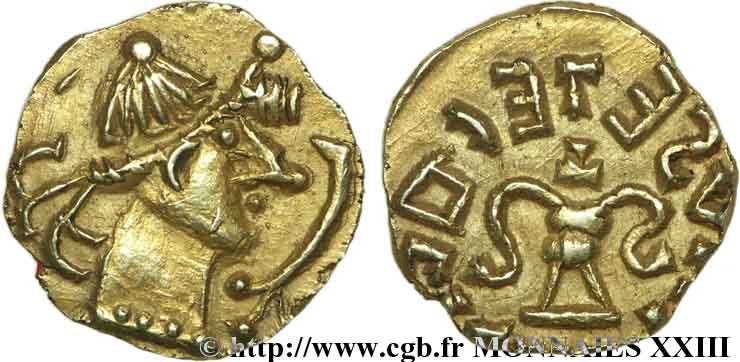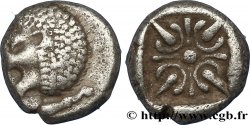v23_0916 - MONETE DELLO MEROVINGI - BANASSAC (BANNACIACO) - Lozere Triens, monétaire ELAFIVS
MONNAIES 23 (2004)
Начальная цена : 2 000.00 €
Назначить цену : 3 500.00 €
Цена реализации : 4 000.00 €
Количество ставок : 9
Максимальная предлагаемая цена : 4 000.00 €
Начальная цена : 2 000.00 €
Назначить цену : 3 500.00 €
Цена реализации : 4 000.00 €
Количество ставок : 9
Максимальная предлагаемая цена : 4 000.00 €
Тип Triens, monétaire ELAFIVS
Дата: (VIIe siècle)
Монетный двор / Город: Banassac
Металл: gold
Диаметр: 12 mm
Ориентация осей монеты: 9 h.
Вес: 1,09 g.
Редкость: R3
Комментарии о состоянии
Belle monnaie, avec une frappe vigoureuse. Droit particulièrement bien centré, mais revers sur flan court
Ссылки в каталоге: :
Происхождение:
Cet exemplaire aurait été acheté en avril 1941. Il provient de la collection Ponton d’Amécourt
Лицевая сторона
Аверс: легенда: ANÉPIGRAPHE.
Аверс: описание: Tête barbare diadémée, à droite ; diadème très saillant à la tranche perlée ; calotte et bouton occipital ; devant le profil, rameau renversé à trois baies.
Обратная сторона
Реверс: легенда: [...]VS ET EIAC[...] RÉTROGRADE.
Реверс: Описание: Calice à deux anses, supportant un T renversé.
Комментарий
Ce triens est celui qui illustre le Belfort, n° 668. La plupart des autres exemplaires ont la légende ELAFIVS MONETA. Le sens de notre légende de revers ne semble pas avoir été compris.
La description du Belfort donne la légende décomposée en ...VS ET EIAT... ; il pourrait s’agir d’une association de deux monétaires, dont ELAFIVS ? Dans la série de triens du Belfort, seul celui-ci a la légende du revers rétrograde. Si seules les lettres étaient rétrogrades, et non le sens de lecture, la légende ...CALETESV... pourrait laisser un doute sur l’attribution au monétaire ELAFIVS. Certains triens avec le nom de monétaire au revers ont la légende BAN à l’exergue, pour BANASSAC.
This triens is the one that illustrates the Belfort, No. 668. Most of the other examples have the legend ELAFIVS MONETA. The meaning of our reverse legend does not seem to have been understood. The description of the Belfort gives the legend broken down into ...VS ET EIAT...; it could be an association of two coins, including ELAFIVS? In the series of Belfort triens, only this one has the reverse legend retrograde. If only the letters were retrograde, and not the reading direction, the legend ...CALETESV... could leave a doubt about the attribution to the coin ELAFIVS. Some triens with the name of coin on the reverse have the legend BAN in the exergue, for BANASSAC
La description du Belfort donne la légende décomposée en ...VS ET EIAT... ; il pourrait s’agir d’une association de deux monétaires, dont ELAFIVS ? Dans la série de triens du Belfort, seul celui-ci a la légende du revers rétrograde. Si seules les lettres étaient rétrogrades, et non le sens de lecture, la légende ...CALETESV... pourrait laisser un doute sur l’attribution au monétaire ELAFIVS. Certains triens avec le nom de monétaire au revers ont la légende BAN à l’exergue, pour BANASSAC.
This triens is the one that illustrates the Belfort, No. 668. Most of the other examples have the legend ELAFIVS MONETA. The meaning of our reverse legend does not seem to have been understood. The description of the Belfort gives the legend broken down into ...VS ET EIAT...; it could be an association of two coins, including ELAFIVS? In the series of Belfort triens, only this one has the reverse legend retrograde. If only the letters were retrograde, and not the reading direction, the legend ...CALETESV... could leave a doubt about the attribution to the coin ELAFIVS. Some triens with the name of coin on the reverse have the legend BAN in the exergue, for BANASSAC








 Cообщить об ошибке
Cообщить об ошибке Распечатать страницу
Распечатать страницу Отправить мой выбор
Отправить мой выбор Задать вопрос
Задать вопрос Consign / sell
Consign / sell
 Информация
Информация










